Sushi is one of Japan’s most popular foods, loved all over the world. If you’re visiting Japan, chances are you’ve already added “eat real sushi” to your travel bucket list.

We Japanese love sushi too—but here’s the thing: there are so many different kinds, each with its own taste and way of being made.
In this post, I’ll share the history of sushi in Japan, the main types (like Edo-mae, maki rolls, oshi-zushi, chirashi-zushi, and fermented iizushi), the different kinds of sushi restaurants (traditional sushi bars and conveyor belt sushi), and even how to eat sushi like a local (hand or chopsticks? what about tea?).
By the end, you won’t just be a sushi fan—you might just become a sushi master.
※寿司は世界中で食べられる人気の日本食です。日本に旅行したら、本場の寿司を食べたいと、来日の予定に組んでいる方も多いはず。寿司は日本人も大好きなのですが、実は種類が豊富で、味や作り方が違います。日本の寿司の歴史や、種類(江戸前、巻物、押し寿司、ちらしずし、飯鮨)、店舗の形(寿司屋と回転寿司)食べ方(手で?箸で?お茶)などを、日本人で寿司好きの私がお教えします。これを見たら寿司通、いえ、寿司博士になれること間違いなしです。
🍣 Introduction | はじめに

Sushi is one of Japan’s most famous culinary treasures—and yes, you can find it almost anywhere in the world these days. But if you’re visiting Japan, you’re in for something truly special.
※寿司は日本を代表する料理のひとつで、今では世界中で食べられています。でも、日本で食べる寿司は特別です。
🕰 A Bite of History | 寿司の歴史

Sushi actually started as a way to preserve fish. In ancient times, fish was stored in fermented rice to keep it fresh. By the Edo period, sushi began to resemble the fresh, hand-pressed nigiri we know today.
※寿司はもともと魚を保存する方法として始まりました。昔は魚を発酵させた米に詰めて保存していたのです。江戸時代になると、今の握り寿司に近い形へと進化しました。

These days, this style is called nare-zushi or ii-zushi, and it’s enjoying a bit of a comeback. Famous examples include funazushi from Shiga and hatahata-zushi from Akita. I grew up in Akita, so I’m especially fond of hatahata-zushi—the unique, tangy flavor from fermentation is just irresistible to me.
※今は「なれずし」とか「いいずし」と言い、人気があります。滋賀の「鮒ずし」や秋田の「ハタハタ寿司」などがそうです。私は秋田で育ったので、はたはた寿司が大好き。発酵した独特の酸味がたまりません。

🍣 Main Types of Sushi | 寿司の主な種類
Japanese sushi can be broadly divided into the following types.
Edo-mae Sushi (Tokyo Style)
Fresh fish is placed on top of vinegared rice and eaten with soy sauce. Sometimes, a sweet and spicy soy sauce sauce is spread on the fish.
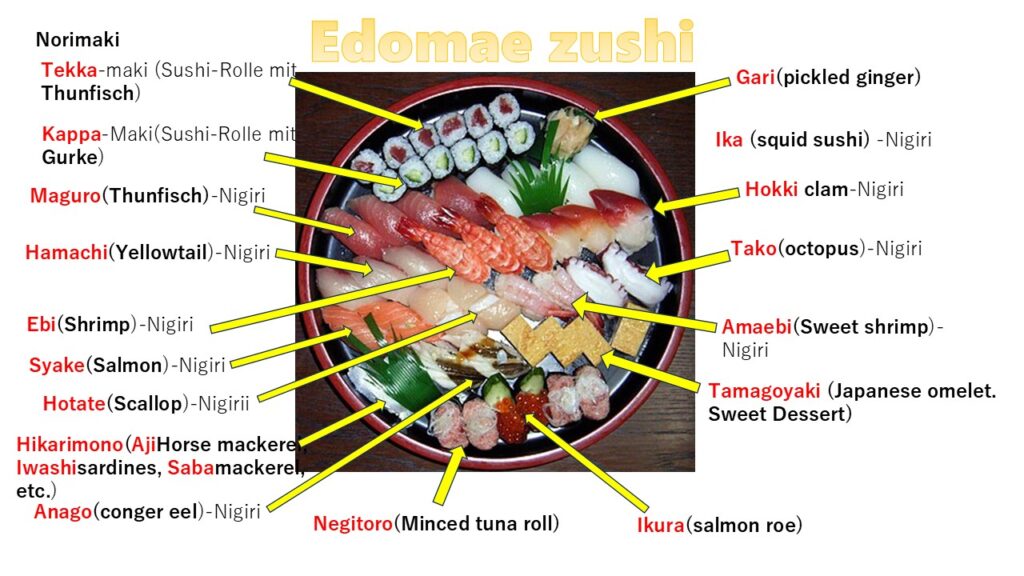
Sushi Rolls
Sushi made by wrapping fish and vegetables in seaweed together with vinegared rice.

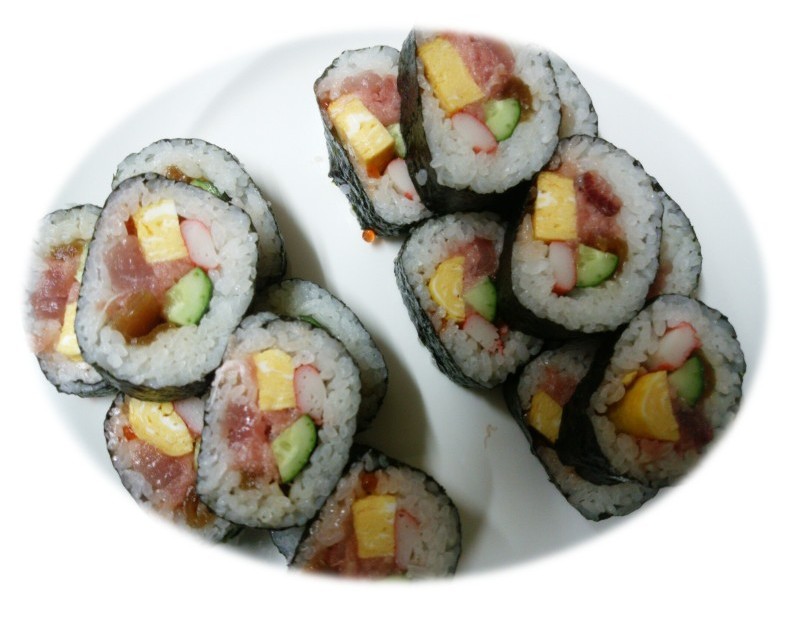
This sushi roll is called Ehomaki, a special kind of sushi that people in Japan eat on Setsubun in February. The one in the photo is actually homemade by me! I filled it with tuna, tamagoyaki (Japanese omelet), imitation crab, and cucumber. Doesn’t it look tasty? My family loved it, and that made me really happy.
Oshi-zushi (Pressed Sushi)
Sushi pressed into shape using wooden molds, popular in the Kansai region.
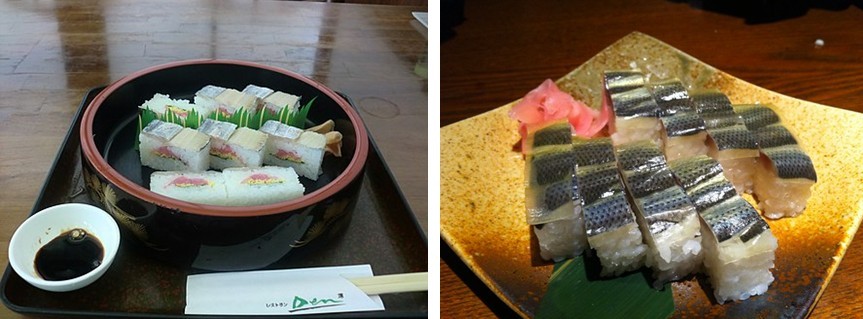
Chirashi-zushi
Sushi with colorful fish and vegetables scattered on top of vinegared rice.
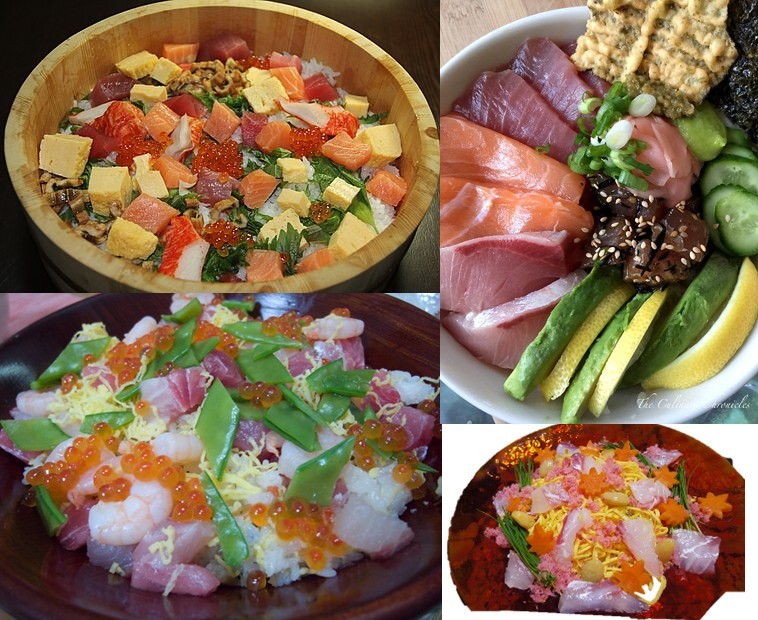

Chirashi sushi is super easy to make as long as you have sushi rice and some toppings. Just decorate it with colorful seasonal fish and veggies and you’re good to go. For example, bright red salmon roe, yellow tamagoyaki (egg omelet), something green like mitsuba or any leafy veggie, and of course some fresh fish like tuna. Just place them on top of the sushi rice and it instantly looks gorgeous. It’s fancy-looking but really simple, so I totally recommend it for parties!
Iizushi (Fermented Sushi)
Traditional sushi made with fermented fish.Typical examples are funa-zushi from Shiga and hatahata-zushi from Akita.
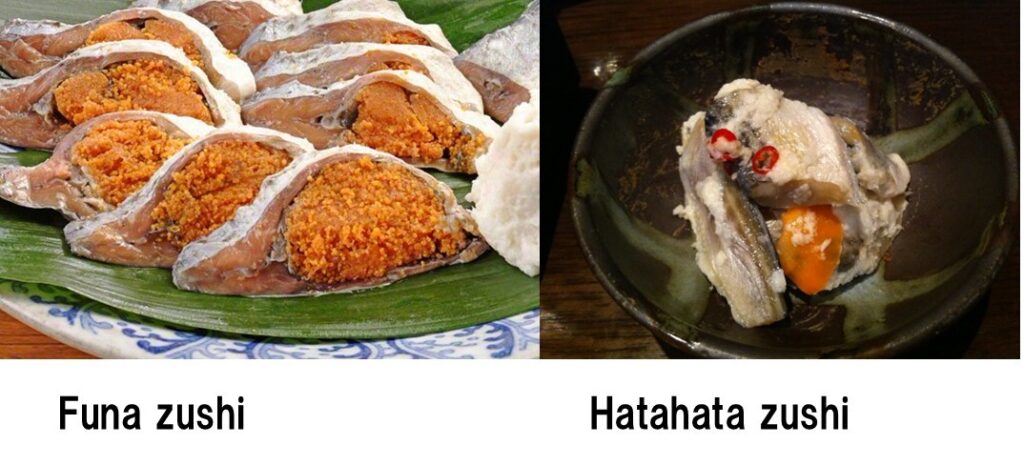
江戸前寿司・・・ 酢飯の上に新鮮な魚を乗せ、醤油につけて食べます。甘辛い醤油だれを魚に塗ることもあります。
巻き寿司・・・海苔で魚や野菜を酢飯と一緒に巻いた寿司。吹き出しの画像は私のハンドメイドの恵方巻です
押し寿司・・・木型で押し固める、関西で人気の寿司。
ちらし寿司・・・酢飯の上に魚や野菜を色鮮やかに散らした寿司。ちらし寿司はすし飯と具材があればだれでも作れます。季節の新鮮な魚や野菜などを彩りよく飾ればよいのですから。赤いいくら、黄色い卵焼き、私は三つ葉をよく使いますが、何か緑色のもの、そしてマグロなどのお魚をすし飯の上に乗せるだけで良いのです。豪華で、パーテイーにもおすすめです
飯鮨・・・ 発酵させた魚を使った昔ながらの寿司。代表的なものは滋賀のフナずし、秋田のはたはた寿司です
🏪 Types of Sushi Restaurants | 寿司店の種類
Where to Eat Sushi in Japan: Two Main Styles
🍣 Sushi Restaurants (寿司屋)

“The Art of Sushi, One Piece at a Time.”
These are the traditional sushi shops with history and pride. Skilled chefs wake up early to choose the best fish at the market, then craft each piece with perfectly seasoned rice.
Watching a sushi chef at work is like watching an artist. The rice is gently shaped in one hand, a slice of fresh fish rests in the other, a touch of wasabi is added, and with a few precise moves, a perfect piece of nigiri is born.
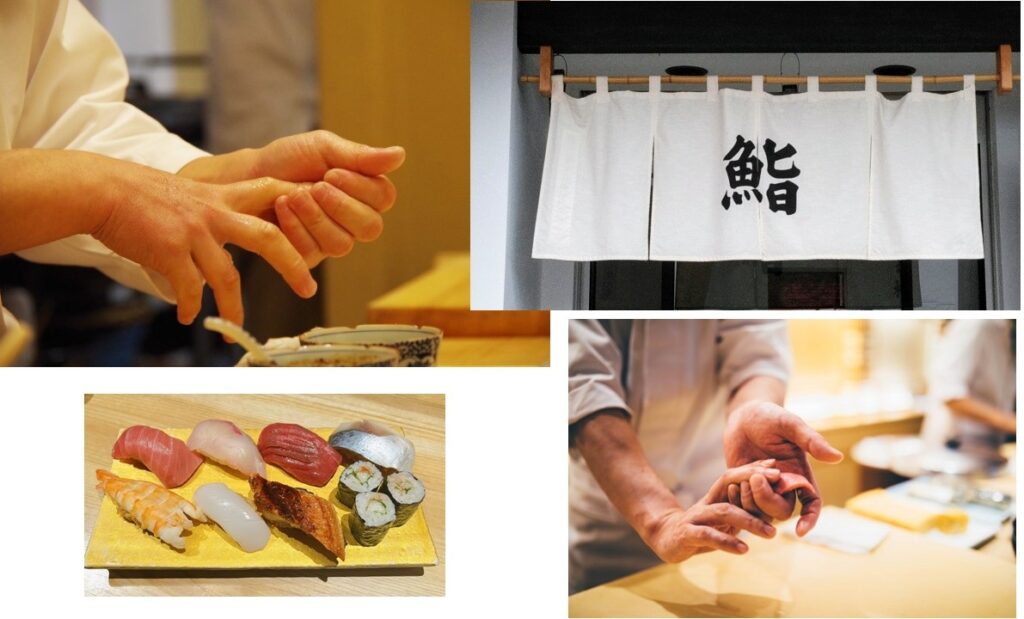
At the counter, you can order directly from the chef or simply say “omakase” (leave it to the chef). You’ll be served the best of the day, and it’s always delicious. Just remember—these places can be expensive. If you see “market price” (時価), don’t be shy to ask the cost before ordering.
🍣 Conveyor Belt Sushi (回転寿司)
Conveyor belt sushi shops are everywhere in Japan. Plates of sushi roll past you on a moving belt, and you just grab what looks good. Many shops also let you order from a tablet with pictures, so language isn’t a problem.
“Fun, Easy, and Budget-Friendly.”
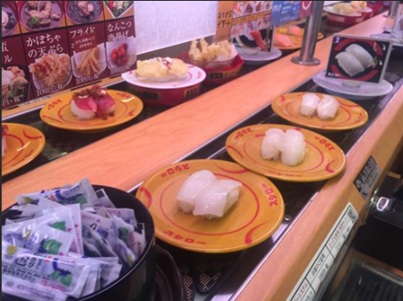
These places are often chain restaurants, meaning they keep costs low. Still, the quality is surprisingly good and fresh enough to win over lots of fans. No market prices here—everything is clear and affordable. Perfect for travelers who want a tasty sushi experience without breaking the bank!
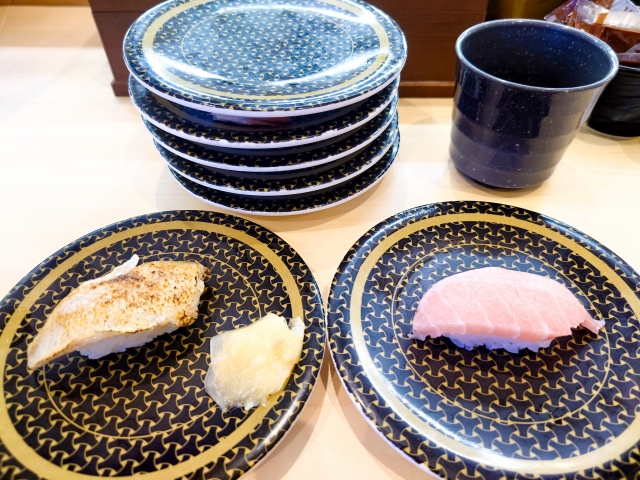

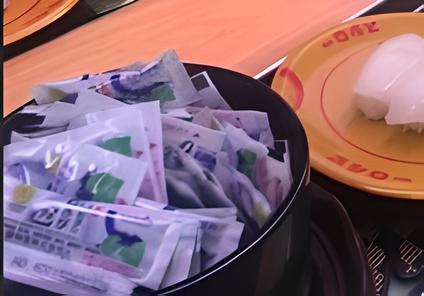
At conveyor belt sushi, the rolls usually don’t have wasabi inside. Don’t worry—you can just grab a free wasabi packet, squeeze some out, and add as much (or as little) as you like on top.
✨ Quick Traveler’s Guide
- Sushi Restaurant (寿司屋) → Authentic, handcrafted sushi, amazing taste, but pricey. Try “omakase” for the chef’s choice.
- Conveyor Belt Sushi (回転寿司) → Casual, cheap, fun, and easy to order (even without Japanese). Great for budget travelers.

Whether you go for the artistry of a traditional sushi restaurant or the fun and affordable vibe of conveyor belt sushi, both give you a taste of Japan you won’t forget. 🍣✨
If you visit Japan, don’t miss the chance to try sushi the local way—it’s one of the most delicious experiences you can have here!
🥢 How to Eat Sushi Like a Local | ローカル流寿司の食べ方
A brief explanation of how to eat sushi

Hand or Chopsticks?

Don’t worry, it’s totally okay to eat nigiri sushi with your hands in Japan! In fact, many people do. Eating by hand keeps the rice and fish together, makes dipping into soy sauce easier, and is perfect for enjoying each piece in one bite. When you’re finished, just wipe your hands with the oshibori (the wet towel or napkin) that’s usually provided.
🍣 Simple Sushi Etiquette Tips
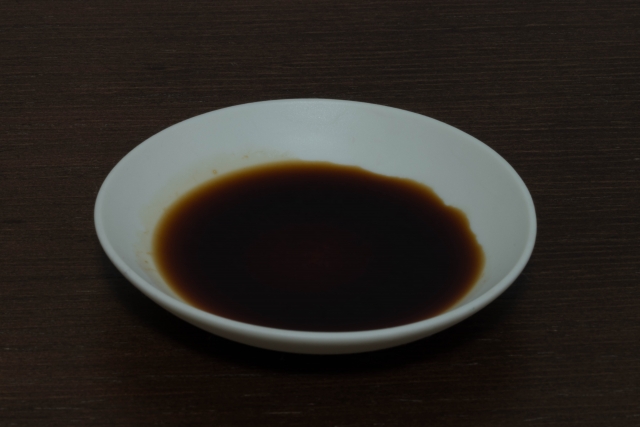
Soy Sauce
When eating nigiri sushi, dip the fish side into the soy sauce, not the rice. This way the rice doesn’t fall apart or soak up too much sauce.
Wasabi
Usually, the chef already adds the right amount of wasabi between the fish and rice. But if you like more, you can add a little on top of the fish before dipping.

Ginger (Gari)
The pickled ginger served with sushi isn’t a topping—it’s for cleansing your palate between different pieces. That way, you can enjoy the flavor of each fish more clearly.
One Bite
Nigiri is meant to be eaten in one bite if possible. It’s the perfect size for that balance of fish and rice.
Chopsticks or Hands
Both are fine! Hands are traditional for nigiri, while chopsticks are usually used for sashimi (sliced raw fish without rice).
Oshibori (Wet Towel)
At the start of the meal, restaurants give you a damp towel. Use it to clean your hands before eating, and again after if you eat with your hands.
🚫 Common Sushi “Don’ts”
- Don’t drown your sushi in soy sauce.
Too much soy sauce hides the delicate flavor of the fish. A light dip is enough! - Don’t mix wasabi directly into the soy sauce.
In Japan, it’s more common to put a little wasabi on the fish itself, not to make a wasabi-soy “soup.” - Don’t put ginger (gari) on top of sushi.
Gari is only for cleansing your palate between bites, not a topping. - Don’t break nigiri into two bites if you can help it.
It’s designed to be eaten whole, so you get the perfect balance of rice and fish. - Don’t rub your chopsticks together.
That gesture suggests you think the restaurant’s chopsticks are cheap or poor quality. - Don’t pass food directly from one pair of chopsticks to another.
This resembles a funeral custom in Japan, so it’s considered very bad manners.
・寿司を醤油に浸しすぎないでください。醤油を過剰に使うと、魚の繊細な風味が隠れてしまいます。軽くつけるだけで十分です!
・わさびを直接醤油に混ぜないでください。日本では、魚自体に少しのわさびを乗せるのが一般的で、わさびと醤油の「スープ」を作るものではありません。
・寿司の上に生姜(ガリ)を乗せないでください。ガリは、一口ごとに口をリフレッシュするためのものなので、トッピングではありません。
・可能であれば、にぎり寿司を二口に割らないでください。全体を一度に食べるように設計されており、米と魚の絶妙なバランスを楽しむためです。
・箸を擦り合わせないでください。その動作は、レストランの箸が安物や品質が悪いと考えることを示唆します。
・箸から直接別の箸に食べ物を渡さないでください。これは日本の葬儀の習慣に似ているため、非常に失礼な行為とされています。
✨ Final Note

Don’t worry too much about the rules—most sushi chefs and staff are very friendly and happy to see you enjoy their food. As long as you eat with respect and curiosity, you’ll be fine. So relax, try different pieces, and enjoy your sushi experience in Japan! 🍣🇯🇵
🎯 Final Bite | 最後にひとこと

Surrounded by the sea, Japan has developed a unique food culture centered on fresh fish. This culture is deeply rooted throughout Japan.
Whether you’re at a Michelin-starred sushi bar or a conveyor belt spot, sushi in Japan is more than just food—it’s an experience.
海に囲まれた日本には、新鮮な魚を軸とした独自の食文化が育まれてきました。この文化は、日本全国に深く根付いています。ミシュラン星付きのスシバーであれ、コンベア式のスシ店であれ、日本のスシは単なる食べ物を超えた体験です。
Related Articles
👉 Conveyor Belt Sushi in Japan: A Fun & Easy Guide for Travelers



Comments